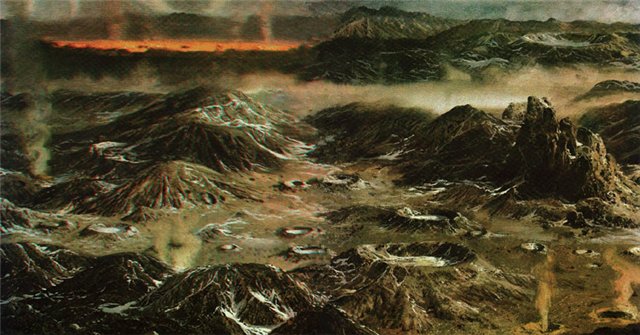
Surface of the Earth during the Hadean eon, perhaps in the later Hephaestean period. Artwork by Zdenek Burian.
| The Hadean Eon | ||
| Hadean | The Palaeohadean Era |
| Hadean (main) |
Geological Timescale | Hadean | Mesohadean (later) |
|
| Precambrian | Timescale Back: Neochaotian (earlier) |
Planetary timescales | Mineral Evolution | Archean |
Timescale |
The Hadean Eon |
 Surface of the Earth during the Hadean eon, perhaps in the later Hephaestean period. Artwork by Zdenek Burian. |
In the new timescale of Goldblatt et al. 2010, the Hadean is divided into three eras, which following the convention of the Archean and Proterozoic eons, are rather arbitrarily defined, and indicated by the prefixes paleo-, meso- and neo-. In this case, the earliest Hadean era, the Palaeohadean (as the authors use the British spelling with its addition "a", rather than the plebian American "paleo") is divided into two periods.
The first, the Hephaestean, began with a molten crust (following the Theia-Tellus collission) which solidified over a period of about 10 My. Even after that time, conditions were extreme. The name is after Hephaestus, the Olympian god of fire and blacksmith of the gods. Although Goldblatt et al. 2010 give an arbitrary time of a hundred million years (one geon) for each period, if specific geological processes are used instead, then that time would obviously differ. So if the Hephaestean is limited to the period of solidification of the crust, that would give the date as from around 4.50 to 4.49 gigayears (give or take ten or twenty million years or so) ago.
For the late Palaeohadean era, the authors suggest the less mythological and more traditional name Jacobian after Australia's Jack Hills, where the earliest zircons have been found. This assumes that the oldest estimated date (Wilde et al 2001) of 4.4 Gyr is correct, otherwise a new name would have to be found. This was also the time of the formation of the oceans, atmosphere, and possibly even the beginnings of life. If the youngest boundary of the Jacobian is around an arbitrary 4.3 gigayears ago, that would give a duration of about 200 million years.
page uploaded MAK110908, edited RFVS111204